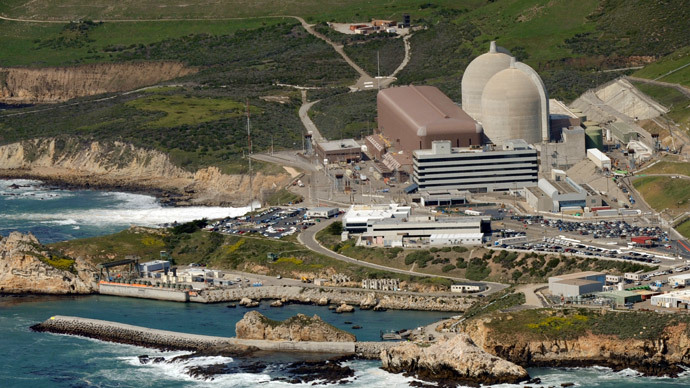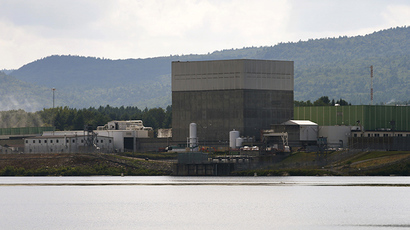California nuclear plant gets thumbs down from expert over quake fears

A confidential report by a senior nuclear expert calls on regulators to close California's last nuclear plant until it can be established the facility can survive a powerful earthquake, according to an exclusive AP report.
READ MORE: Fukushima lessons: US nuclear plants ‘must be better equipped for offsite disasters’
The Diablo Canyon Power Plant, which was built near three
geographical fault lines, provides electricity needs for more
than 2.2 million people in America’s largest state. However, a
confidential report by the plant’s former inspector, Michael
Peck, is calling on federal regulators to pull the plug on the
facility.
Following the closure of the San Onofre Nuclear Generating
Station in 2013, 30-year-old Diablo Canyon is the sole remaining
nuclear energy supplier in California.
Peck warned in his 2013 report, which was obtained and verified
by the Associated Press, that the Nuclear Regulatory Commission
(NRC) is failing to maintain safety standards previously put in
place for the facility's operation.
The primary issue, as described by AP, is that “no one knows
whether the facility's equipment can withstand strong shaking
from those faults - the potential for which was realized decades
after the facility was built.”
Continuing to operate Diablo Canyon plant “challenges the
presumption of nuclear safety,” the nuclear expert, who is
employed as an instructor by the NRC, warned.
The surfacing of the confidential report comes after a
magnitude-6 earthquake hit northern California on Sunday,
injuring dozens of people and causing over $1 billion dollars in
property losses. Fears that Sunday’s earthquake was just a
precursor to the much-feared ‘Big One’ have once again sparked
debate on the ability of California’s aging infrastructure to
withstand an earthquake.
Meanwhile, nuclear experts continue to be haunted by the
nuclear accident at Japan’s Fukushima nuclear plant, which
suffered severe damage following a magnitude 9.0 earthquake and
tsunami that hit Japan in March 2011. To this day, Japanese
authorities, amid a very concerned public, are attempting to halt
the leak of radiation from the damaged structure.
In a report put out in July entitled, “Lessons Learned from the Fukushima Nuclear Accident for Improving Safety of US Nuclear Plants,” it is advised that the nuclear industry should "access their preparedness for severe nuclear accidents associated with offsite-scale disasters."
It adds that the current approach to nuclear safety is “clearly inadequate for preventing core-melt accidents and mitigating their consequences."

After the Fukushima disaster, the NRC ordered US nuclear plants
to reevaluate the risks posed by earthquakes, with studies due by
March 2015.
Much of the current debate over the viability of California’s
last nuclear facility originates from the 2008 discovery of the
Shoreline fault, which, together with a number of other
potentially active regions, including the large Hosgri fault,
arguably places Diablo Canyon in a vulnerable geographical
position.
Peck says Pacific Gas & Electric (PG&E), the company that
owns the nuclear facility, failed to prove that the plant would
withstand the vibrations of a powerful earthquake, thereby
violating its operating license. PG&E has challenged those
claims, saying the structure is sound.
Blair Jones, a spokesman for PG&E, the company that owns the
nuclear facility, said the NRC has conducted extensive analysis
to prove the plant is “seismically safe.”
Jones told AP that concerns regarding earthquake-generated
movements of the nuclear plant, which could potentially lead to a
disaster, were put to rest in the 1970s following “seismic
retrofitting” of the facility.
In 2012, the NRC supported preliminary studies that said
vibrations and aftershocks coming from the Shoreline fault would
not jeopardize the structural integrity of the reactors.
Meanwhile, the release of the confidential report has sent
shockwaves through California's political circles.
Sen. Barbara Boxer, a California Democrat who chairs the Senate
Environment and Public Works Committee, expressed alarm that
Peck’s report has only surfaced now.
“The NRC's failure to act constitutes an abdication of its
responsibility to protect public health and safety,” she
said.
The committee announced it would hold hearings into how the NRC
has responded to Peck's suggestions.
Peck, currently an instructor at the NRC's Technical Training
Center, declined to comment on the AP report.














